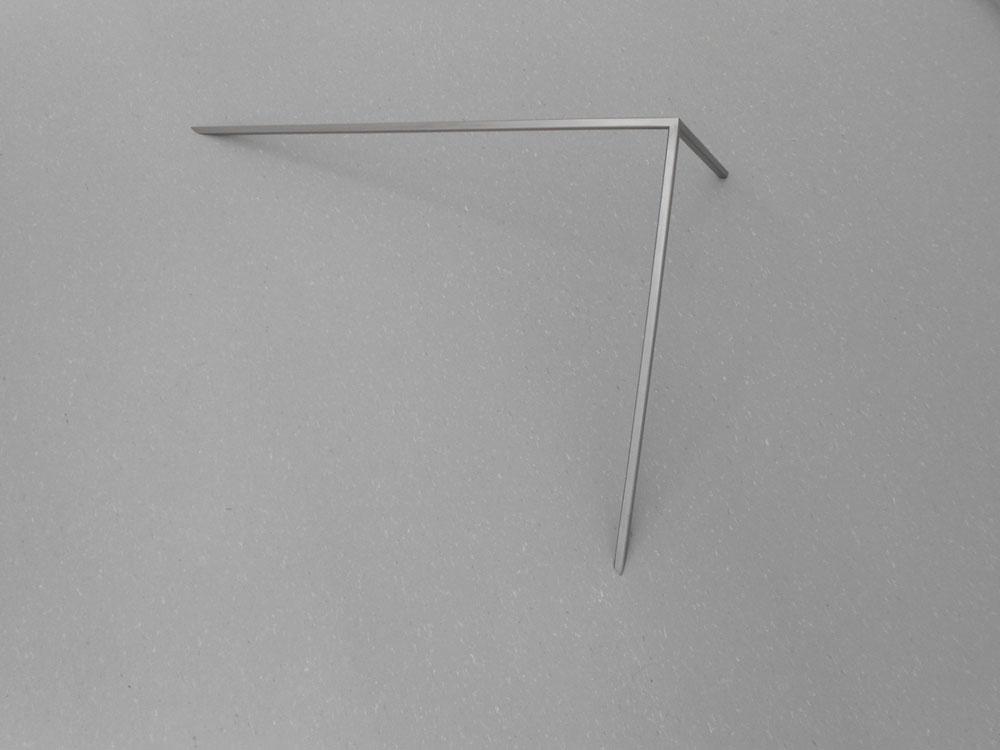“Toolkit,” the inaugural exhibition at MKG127’s new location on Dundas West in Toronto, has been curated by Vancouver-based artist Germaine Koh. “Toolkit,” she writes in an essay accompanying the exhibition, “is an exhibition of human-scaled objects that give pause for thought.”
And indeed they are, and indeed they do—though the pauses for thought that they afford, and often require, do vary considerably, I would say, in length and ruminative depth.
The first work you encounter—it’s the piece closest to the door in this new, bright, boxcar-shaped gallery—is Onkar Kular’s Deformed Cutlery(from his Machines for Living series of 2002 to 2004). It consists of a knife, fork and spoon, each treacherously modified in a slapstick sort of way: one tine is missing from the fork, for example (which leaves it inelegant but not really unusable); the spoon has a hole drilled into it (like the holes in the dribble glasses they used to sell in joke shops); and the knife’s blade has suffered a horrid abrasion just at the point where most of the cutting would normally happen.
Now presumably this isn’t joke-shop stuff, but rather a reflection upon (to use Koh’s phrase) “how we are shaped (literally even) by our habits.” The phrase “literally even” is clever. But it’s hard, at the same time, to feed it back into the work. And being “shaped by our habits” is too big and bland to be of any use. What makes the piece a work of art and not just a goofy joke? The fact that the wounded pieces of cutlery are languishing in a vitrine?
The same sort of vaudevillian, one-liner bathos stalks Daniel Olson’s initially funny but ultimately dispiriting (and way too cutely named)Citizen Cane works from 1998. Seven of these walking-cane multiples are displayed, each of which bears a bicycle bell affixed to its upper curve-handle, the bell announcing, as Koh mordantly puts it, that the cane’s user “won’t take reduced mobility sitting down.” But does it really—all joking aside—say this? For me, the bells are pathos-imbued engines of overcompensation. Does cane-speed require a get-out-of-my-way warning? If it doesn’t, the work is condescending and pathetic. If it does, then isn’t the whole situation edging rapidly towards an animated-cartoon species of bleak/black humour?
A few of the tool-works in the exhibition lie somewhere in the droll space between absurdity and functionality: Heidi Nagtegaal’s sweetly winning Day-Glo orange crocheted traffic pylons (2008–10) belong there, for example, as do Instant Coffee’s West Coast Stools from this year (two rough-hewn tree stumps, now brightly painted), Gologorsky Studio’s red, recycled-plastic TILT stools, also from 2012 (worthy design objects), and Michel de Broin’s Reparations (2004), a homemade bottle launcher along with its carrying case, plus videos of successful launches in various far-flung locations.
By and large, the tool-objects that work best in “Toolkit” are the ones that appear to work the least: Ken Nicol’s introverted, stainless-steel, key-wound small box that tics (2007), for example, ticks on forever, like a sonic hourglass indexing your life, making nothing happen, preventing nothing from happening, monitoring nothing—as it gradually runs down (only to be wound up again). His Clock of Doom (2008) is even more unsettling—a mute, faceless clock that ticks towards some inevitable but unpredictable moment when (we are told) the alarm will go off: a consummation without context or reward.
Chris Lindsay’s two POD (point of departure) works from 2011 are small metal drawings in space, each of them consisting of three lengths of steel welded into right angles. When placed on the floor, they seem like outcroppings of vaster geometric constructions, now lost in the space beneath the gallery. Are these tools? They’re closer, maybe, to perceptual toys. But they’re undeniably haunting.
The same is true of Sonny Assu’s exquisite and quiet, but lethally satirical, copper cup and lid from his Disposable Wealth works (2009): a noble conflation of the First Nations potlatch tradition and the disposable culture in which such traditions get frayed and come apart (the lidded copper cup is a wicked reworking of fast-food take-out cups and lids). This is one of the two genuinely moving works in the exhibition.
The other—and the highlight of “Toolkit,” for me—is Sascha Pohflepp’s Buttons (2006–11), a brilliant object that looks like a normal camera but is, as Koh puts it, a “blind, lensless but networked camera.” When you press the shutter button, it captures an image that is not one you have sought, but one you are offered: an image chosen for you from all of the images online that were taken at the precise moment you think you took your photograph. As Koh remarks, Pohflepp’s camera (and its stand-alone smartphone app) “reveals our connections to others.” Whether we want them or not.









